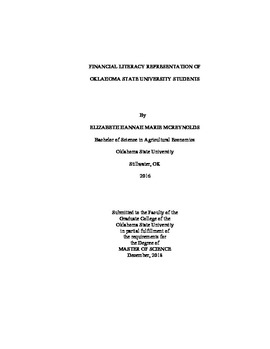| dc.contributor.advisor | Jones, Rodney | |
| dc.contributor.author | McReynolds, Elizabeth Hannah Marie | |
| dc.date.accessioned | 2019-07-19T14:49:28Z | |
| dc.date.available | 2019-07-19T14:49:28Z | |
| dc.date.issued | 2018-12-01 | |
| dc.identifier.uri | https://hdl.handle.net/11244/321008 | |
| dc.description.abstract | Financial literacy rates across the United States are in general considered low. The research question being addressed is whether or not the typical educational experience at OSU adequately addresses the financial literacy needs of OSU students. Low financial literacy is a serious problem that leads to poor choices regarding significant financial decisions. Numerous studies have evaluated financial literacy rates of undergraduate and high school students. This study builds on previous literature by determining the financial literacy of Oklahoma State University (OSU) graduate students, particular demographic groups, and determining the effectiveness of an undergraduate personal finance course at OSU. | |
| dc.description.abstract | To achieve the objectives the study used a t-test to determine if the Jump$tart coalition national average from the 2008 survey was statistically different from the average financial literacy rate of graduate and undergraduate students at OSU. Particular demographic groups were analyzed by using regression to determine if demographic groups affect the financial literacy score determined by the survey. A t-test was used to determine the effectiveness of an undergraduate personal finance course at OSU by comparing the pre-course average and the post-survey average to see if the course increases financial literacy based on the scores of the survey given. | |
| dc.description.abstract | The study found that OSU undergraduate students did not score significantly different from students that participated in the 2008 Jump$tart coalition college survey, but graduate students at OSU did score significantly different. According to the study classification of a student (part time versus full time), race, student's place of origin, and gender all have significant impacts on financial literacy. The study also found that the personal finance course evaluated at OSU did not improve student's average financial literacy score. Overall, the study concluded that there is a need for improvement in financial education at Oklahoma State University. The findings of this research will provide further insights into opportunities for the university to evaluate and improve the current personal finance initiative. | |
| dc.format | application/pdf | |
| dc.language | en_US | |
| dc.rights | Copyright is held by the author who has granted the Oklahoma State University Library the non-exclusive right to share this material in its institutional repository. Contact Digital Library Services at lib-dls@okstate.edu or 405-744-9161 for the permission policy on the use, reproduction or distribution of this material. | |
| dc.title | Financial Literacy Representation of Oklahoma State University Students | |
| dc.contributor.committeeMember | Woods, Michael Denton | |
| dc.contributor.committeeMember | Shideler, David W. | |
| osu.filename | McReynolds_okstate_0664M_15962.pdf | |
| osu.accesstype | Open Access | |
| dc.description.department | Agricultural Economics | |
| dc.type.genre | Thesis | |
| dc.type.material | Text | |
